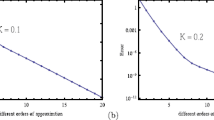Abstract
The mechanical and thermal characteristics of the self-similar boundary-layer flows induced by continuous surfaces stretched with rapidly decreasing power-law velocities U w∝x m, m<−1 are considered. Comparing to the well studied cases of the increasing stretching velocities (m>0) several new features of basic significance have been found. Thus: (i) for m<−1 the boundary layer equations admit self-similar solutions only if a lateral suction is applied; (ii) the dimensionless suction velocity f w<0 must be strong enough, i.e. f w<f w,max(m) where f w,max(m) depends on m so that its absolute maximum max (f w,max(m))=−2.279 is reached for m→−∞, while for m→−1, f w,max(m)→−∞; (iii) the case {m→−∞, f w,max(m)=−2.279} of the flow boundary value problem is isomorphic to the stretching problems with exponentially decreasing velocities U w∝eax with arbitrary a<0; (iv) for any fixed m<−1 and f w<f w,max(m) the flow problem admits a non-denumerable infinity of multiple solutions corresponding to the values of the dimensionless skin friction f ″(0)≡s belonging to a finite interval s∈ [s min(f w,m), s max(f w,m)]; (v) the solution is only unique for f w=f w,max(m) where s=s min(f w,m)= s max(f w,m) holds; (vi) to every one of the multiple solutions of the flow problem there corresponds a unique solution of the heat transfer problem with a wall temperature distribution T w−T ∞∝x n and a well defined and distinct value of the dimensionless wall temperature gradient ϑ′(0), except for the cases n=(|m|−1)/2 where ϑ′(0) has the same value ϑ′(0)=Pr·f w for the whole class of flow solutions with s∈[s min(f w,m), s max(f w,m)]; (vii) for f w→−∞ one obtains the `asymptotic suction profiles' corresponding to s=s min(f w,m)≅f w and ϑ′(0)≅Pr·f w in an explicit analytic form. The paper includes several examples which illustrate the dependence of the heat and fluid flows induced by surfaces stretching with rapidly decreasing velocities on the physical parameters f w, m, n and Pr.
Similar content being viewed by others
Author information
Authors and Affiliations
Additional information
Received on 4 May 2000
Rights and permissions
About this article
Cite this article
Magyari, E., Ali, M. & Keller, B. Heat and mass transfer characteristics of the self-similar boundary-layer flows induced by continuous surfaces stretched with rapidly decreasing velocities. Heat and Mass Transfer 38, 65–74 (2001). https://doi.org/10.1007/s002310000126
Issue Date:
DOI: https://doi.org/10.1007/s002310000126




